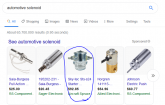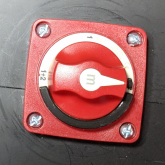Farmgirl0527
New Member
- Joined
- Dec 29, 2019
- Messages
- 83
Anyone ever just use a 100 watt light bulb.
A solenoid translates electrical energy into physical movement, are you thinking this device would move a switch to an alternative position or are you thinking of a contactor/relay where energising the coil pulls over switch contacts (...and resets them when de-energised)?The capacitors would only be about 1/2 charged when the Solenoid trips
A solenoid translates electrical energy into physical movement, are you thinking this device would move a switch to an alternative position or are you thinking of a contactor/relay where energising the coil pulls over switch contacts (...and resets them when de-energised)?

If when you say 'solenoid' you mean contactor, then you can do all the time constant tweaking you want, you're still going to have a permanently enrgised heavy duty coil.
Regards,
David.
Just buy a £1 resister, a £15 rotary switch and suffer the 30 seconds inconvenience it takes to pre-charge manually! ;-)
Totally agree, in my tests, even milli-ohm resistances cut the current to manageable levels.However, in my installations I will be using a smaller resister, perhaps as low as 10 ohms for a 12 volt system.
Totally agree, in my tests, even milli-ohm resistances cut the current to manageable levels.
It's quite a useful circuit to re-visit time-constants, inductive load behavior and the like. Had some fun modelling it
Have you every used 'everycircuit' simulator?
I was thinking of maybe using one of those solenoid-operated automatic transfer switches used to break>make grid>local off-grid supplies.
The Victron has a voltage sense input, I'm just using some 14 or 16ga cable for it. Should I wire the positive side of the voltage sense cable to the switch or directly to the pos batt terminal? From what I understand, a voltage sense circuit will be really high resistance, and won't have any parasitic drain when the rotary switch is in the OFF position. Right?
I spent a *little* time trying to think of any problem with having the voltage sense hooked up while the primary Positive is disconnected but I don't think there would be.... particularly not with a Victron (They tend to be pretty solid designs)
So.... I would put it on the positive of the terminal, not the switch.
How do you like the victron? My next install is going to include a MultiPlus.
It shouldn't be a problem, side effects can be: when multi is powered from AC with battery disconnected: you can get a battery sense error when the voltage difference between the sense input and battery terminals is too big.






I know this thread is fairly old and have not gotten to the bottom of it yet. I am new to inverters and solar but have came a long way, I thought, until now ugh! I cannot seem to wrap my head around how to charge/discharge capacitors NOW after reading this far lol I thought it was as simple like in Wills video. This is my scenario. 3000w/6000w 12v wzrelb reliable inverter, battery cables 1/0, 2 npp 6v 180ah batteries in series. I will not have a momentary switch installed, it will be identical to Will’s video touching the resistor to the battery to get precharge. At first I was going to use 20w 30ohm resister like in the video, but after reading all of this which REALLY confuses me now. Could I still use that resister and touch them or is there the thermistor I need to use? That’s where I’m stumped because 12v SERIES, set up. Thanks to anyone who helps out with this! BTW, my system will be set up, used for a week, then taken down and transported back home from cabin 1x a year.Ah Filter. In your case I can see the desire to disconnect completely. But your situation works fine with a check-list:
Powering up
1) Confirm Inverter Switch is OFF.
2) Turn switch X to position 1 count to five.
3) Turn switch X to position 2.
4) Turn ON inverter.
Powering down before leaving
1) Turn OFF inverter.
2) Turn switch X to OFF.
I knew it was good to charge inverter capacitors and discharge them is what led me to this thread. Then got completely confused trying to follow the thread, just knowing there are variables way over my head, but still want to be safe. Thanks for the reply!
I knew it was good to charge inverter capacitors and discharge them is what led me to this thread. Then got completely confused trying to follow the thread, just knowing there are variables way over my head, but still want to be safe. Thanks for the reply!
@Delaware79 ,
If you are doing the one-time resistor pre-charge, the PTC resistor is not needed. It is strictly a safety for a miss-use case when you have the switch with the built in pre-charge.
I’m not sure if my inverter has a built in precharge switch, I’ll have to research as the manual doesn’t explain much. It’s good to know when the precharge is needed. If mine has a built in precharge switch, would I be hurting it if I do a precharge not knowing whether it has one or not? I’m not sure I’ll be able to find that anywhere if it has one or not
The value of the resistor for the one-time pre-charge can be almost anything from 3-50 ohms.
@Delaware79 ,
If you are doing the one-time resistor pre-charge, the PTC resistor is not needed. It is strictly a safety for a miss-use case when you have the switch with the built in pre-charge.
I’m not sure if I have the switch with the built in precharge
The value of the resistor for the one-time pre-charge can be almost anything from 3-50 ohms.
I’m not sure if my inverter has a built in precharge switch, I’ll have to research as the manual doesn’t explain much. It’s good to know when the precharge is needed. If mine has a built in precharge switch, would I be hurting it if I do a precharge not knowing whether it has one or not? I’m not sure I’ll be able to find that anywhere if it has one or not
The large surge is not good for FETs in a BMS.


